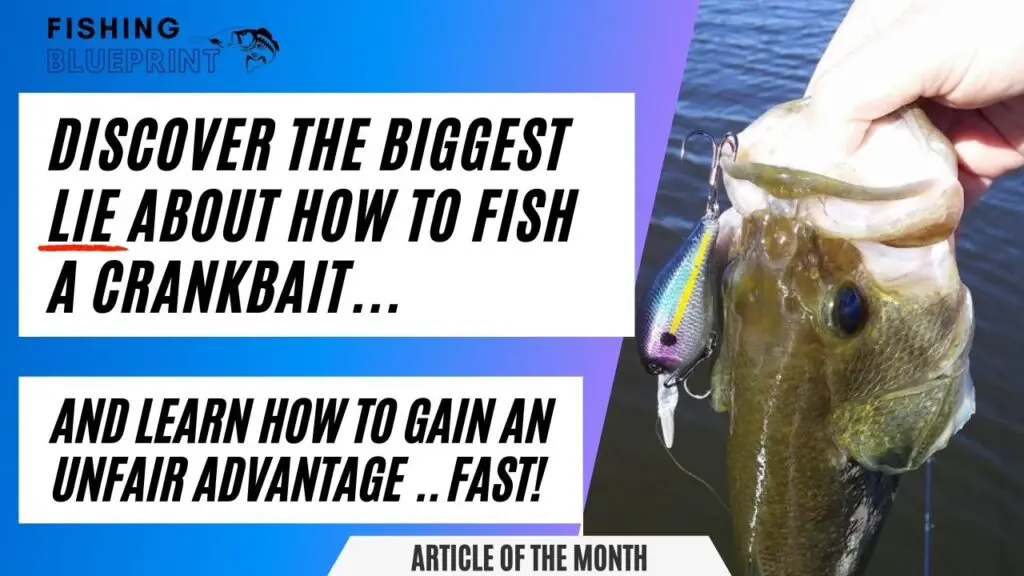Bass Fishing Rocky Banks| Fishing Rocky Banks and Riprap For Bass
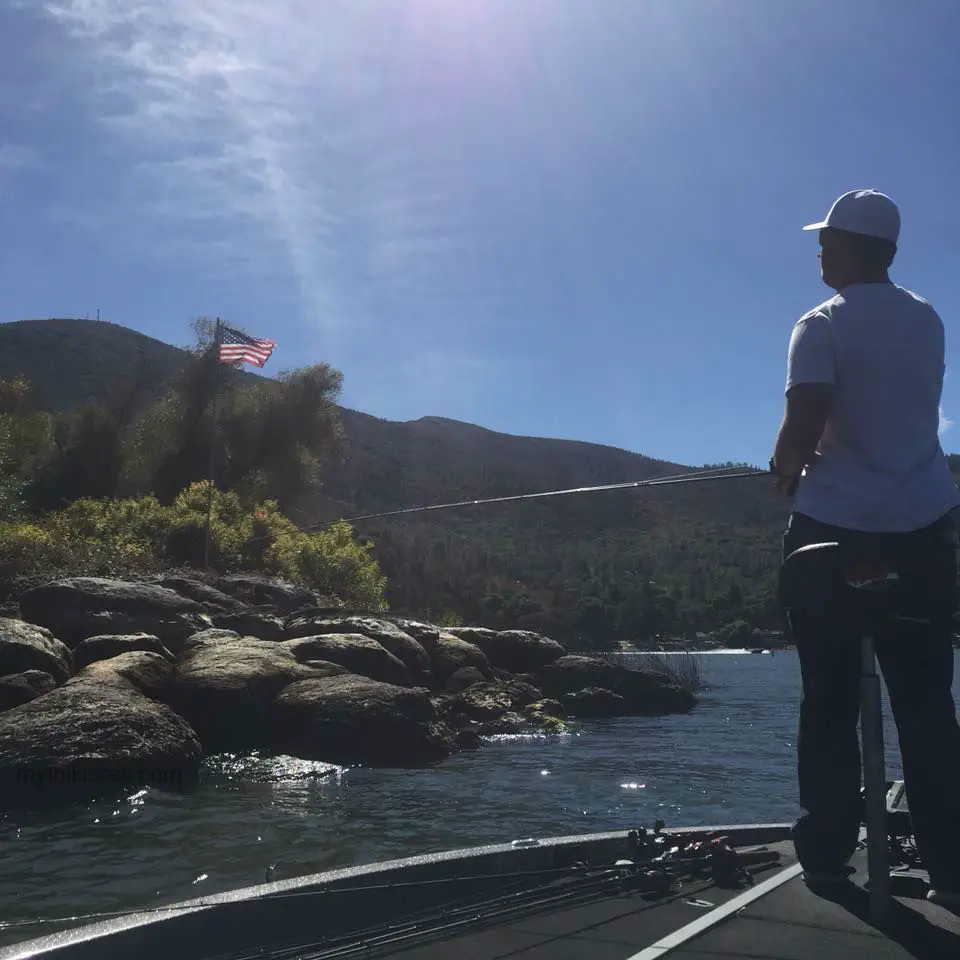
One thing is certain: not all rocky banks are made the same.
The key to bass fishing rocky banks are: (1) looking for certain sorts of rocky banks that have a greater likelihood to hold fish; (2) knowing when to fish riprap throughout the year; and (3) understanding what baits work best.
Occasionally, if you visit any large lake you’ll see tons of rocky banks… and… choosing where to start can be certainly overwhelming! And to make matters worse, most of these banks you’ll encounter may have the occasional fish near them, but the majority will have no fish at all.
To be blunt with you there are only two ways to become successful with fishing rocky banks.
I used to do it the old way… that is to spend hundreds (if not thousands) of hours on the lake fishing and scanning every single bank that I stumbled across. But… for me (and more likely you as well) I didn’t have the time or the money to waste!
Does this ring true to you too?
The new way is to fish these in a surgical systematic way that can instantly give you the green light to start fishing and catching bass!
Now take a second to think about this… Can you imagine yourself having the confidence to pull up to any bank and instantly know whether it can be fished or not? Can you see how many more fish you can catch in one day just knowing that? Wouldn’t that be awesome?
Heck yes it would! Listen, If you ever got suckered into fishing at the wrong rocky bank, you know it can be similar to being in a barren ghost town, wasting hours of your day, or forced to deal with a painful arm, or worse! – I know the feeling too!
In our fishing blueprint, we’re going to help you avoid all that…
Are you ready to break down and dive into each one of these steps?
Perfect! Let’s get started…
Key Takeaways
Thankfully, bass fishing has become second nature to me now… but that wasn’t always the case. As I spent thousands of hours watching and learning from my mentors, practicing hundreds of hours on the lake… only to fail horribly…
However, over years of honing my skill whenever I had the chance, I slowly started to create my personal rock bank fishing blueprint for beginners, which is kinda-like my private set of strategies and tactics. Now whenever I get to the lake and see these types of banks, I use my same blueprint and I can quickly pick out the best locations that are most likely to hold fish… which allows me to avoid wasting hours of my fishing day… would you like to know more? Great, here are just some of the things in this blueprint you’ll learn how to fish rocky banks for bass:
- Understand what rock banks types are more likely to hold fish… and… which to avoid as fast as humanly possible!
- How your PC can get you extra bites when you’re on the water!
- How you can legally check to see if the banks attracts bass… even if the bank looks like the hundreds of other banks in the area… you will get your answer in less than 1 minute… and helps you avoid spending countless hours on the wrong fishing spot!
- The single best way fish a rocky bank… this strategy will allow you to catch all the fish… never worry about spooking the rest… even if fish jumps off your hook!
- Learn the best one-two punch for making bass bite when your fishing rocky banks – even Mike Tyson would be proud!
But be warned! Go through this blueprint slowly and carefully so you don’t miss any tips that could cost you.
Rock Bank Primer
Rocky banks can be excellent places to hook into bass. These areas provide cover for bass as they wait to ambush prey on rocks and boulders on the rocky bank.
Shad and other prey fish hide in the small gaps between rocks and behind them, so they are an excellent place for bass to wait for their prey.
Shade is another benefit that rocks provide for bass. Large rocks and boulders are perfect spots that are cooler due to the shade they provide on hot summer days.
Rocks also provide protection for bass from their prey.
Helpful Tip: About half of the lakes in this country are natural lakes while the other half are manmade. natural lakes usually have rocky banks with rocks randomly arranged by nature along the bank.
Manmade lakes have riprap banks covered with these manmade rocks placed there by huge dump trucks. Riprap is placed on the banks to avoid erosion of soil.
You may wonder why it matters how the rocks are arranged. This is because as an angler, you need to know that bass look for differences in rock arrangements and for anomalies in the rocks.
Bass are finicky fish who will go out of their way to rest and hunt prey in a place that is different from the rest. Fishing the spots where bass will probably be located saves time and makes for efficient fishing that can load up your boat with lunkers.
The first rule for fishing bass on rocky banks or riprap banks is to look for differences. These could be places where yards of similar rocks change to larger or smaller ones or a spot with a laydown near the bank.
Both natural and manmade rock banks can hold bass and are great places to fish bass.
They both absorb sunlight and raise the water temperature, and this attracts both bait fish and bass.
Natural rocks do not extend beyond the spot where they sit on the lake bank. Riprap may extend onto the lake bottom in a sloped manner down into the deeper water that is usually near the bank.
Step 1: What Are the Different Types of Rocky Banks... and... Why Are They Important?
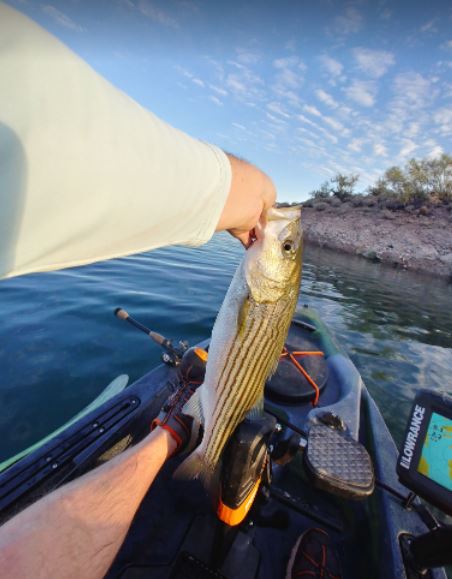
Almost every lake has some type of rock, whether pebbles or larger rocks. In natural lakes, you may find gravel that was once larger but has been worn down by moving water.
In bass fishing here is how I define the sizes of rock:
- Gravel is defined by the presence of marble sized rock.
- Small chunk rock is baseball to softball sized rock.
- Whereas rip rap is defined as basketball sized to large moving box-sized rock.
- Boulders are big chunks of rock that are as big or bigger than a table.
Gravel is normally found in shallow water primarily in the backs of coves. Knowing where curtain gravel is is important for spring spawn fishing. Bass will head back into the shallow warmer water and make their spawning beds on gravel.
Small chunk rock is the type of rock that is usually placed on banks and around docks and other structures. Many of these rocks look almost identical. Normally you’ll see small chunk rock on channel bends and at the end of bluff walls which could provide great fishing.
Helpful Tip: There are also small chunk rocks and boulders that may have taken years to become their present shape. Some boulders are as large as 30 feet across, such as those at Lake Powell in Arizona.
Riprap (or large sized chunk rock) is most commonly made from the construction of reservoirs and manmade lakes. It’s uncommon to be found in natural lakes unless the lake has rivers flowing into it where they will take the form as large sized river rocks on the trailing side of riffles.
Manmade riprap is normally placed on the bank or in specific locations such as a windbreaker for marinas, bridges, culverts, drainage pipes, or tossed to either side during boat ramp construction.
The vast majority of the time riprap banks are going to be your best all-round bet for finding and catching fish. Baitfish and critters will live, feed, and hide in these areas in every season.
Large riprap and boulders are sometimes placed in manmade lakes. They are a prime spot to fish bass who like to hide behind the large rocks because of their added shade and protection.
What Are Rock Transitions?
It is important to know what a transition from one type of rocky substrate to another looks like to the angler. The entire lake bank, especially in a manmade lake, may all look the same at first glance.
There are some anomalies that anglers can look for because slight differences often attract big bass.
When you begin to carefully evaluate the lake bank, it is easy to see if the size, shape, or texture of rocks along the bank changes. This transition from one type of rocky substrate to another is a favorite hiding place for bass and their prey fish.
Helpful Tip: Some lakes may have miles of rock banks that appear to be almost the same. When you take a closer look, you may find that the same rocks do not continue along the lake bank, but smaller or larger rocks suddenly appear and go down the bank for some distance.
Other changes that anglers should look for are changes in the lake bank such as a slight turn or a fallen tree or laydown right beyond the rocky bank. Bass are attracted to changes in the lake bank where they can hide and wait for prey.
Some transitions can be almost unnoticeable. An example may be that a thicker dump of riprap was placed in one area but not on the rest of the bank.
Bass will likely choose this spot to rest and wait for prey to swim by.
Step 2: Finding Quality Rocky Banks at Home First
One of the best ways for anglers to find potential quality rocky banks is with Google Maps. This website can show you a birds eye view of all the banks on your lake.
Each lake is different, but there are some common places to find rocky banks in most lakes. Bass will not be found on every rock, but you can check your lake to discover the places where they hide behind and in between the rocks in your lake.
Here are what I consider the 3 prime rocky banks locations for beginners to fish, plus a bonus location… please note… there are more locations to learn, but I don’t want you to be overwhelmed. With that being said, if you’re going to be bass fishing rocky banks, these have a better than average chance of holding bass. And they’re going to be:
- (A) Channel swing banks
- (B) Leading and trailing edges of bluff/cliff walls
- (C) Marinas
- BONUS: Backs of creeks with current
It’s really easy finding rocky or riprap banks on Google Maps.
- Simply, pull up Google Maps and start looking at your favorite areas on the lake.
- Next, zoom in and inspect the bank.
- Then find the prime bank locations that we previously discussed.
- As you find quality rocky banks, save the GPS coordinates and plug it into your fish finder for you to use later.
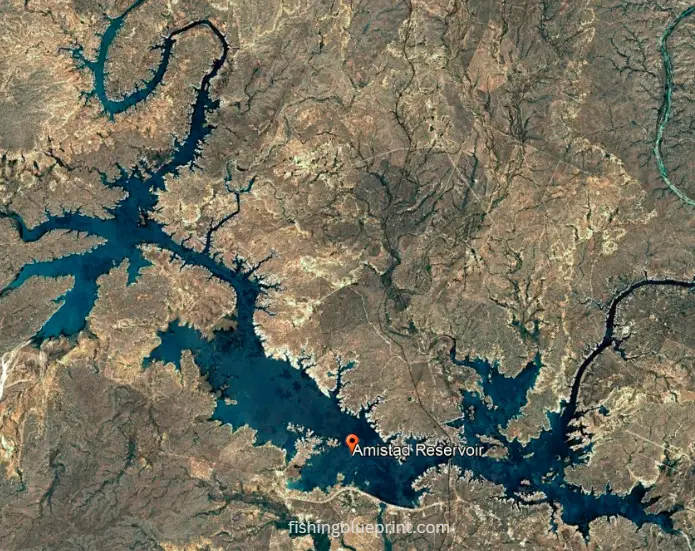
In this example, Step 1 – Pull up Google Maps and start looking at your favorite areas on the lake.
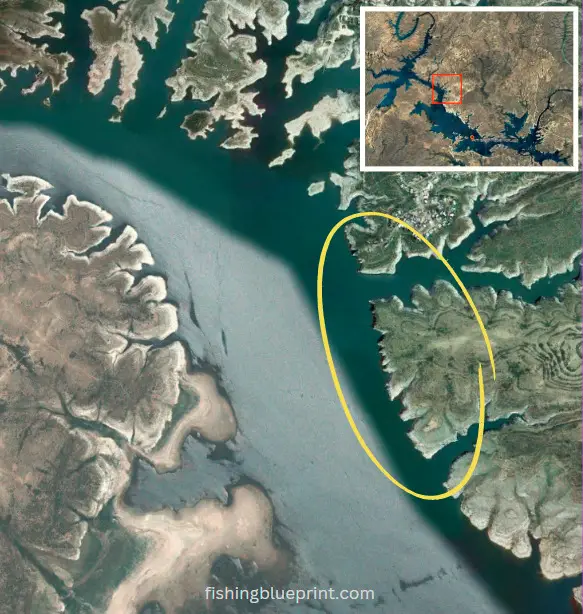
Step 2 – Zoom in and inspect the bank. For this example we are looking for rocky channel swing banks…
Step 3 – Find the prime bank location and save the GPS location.
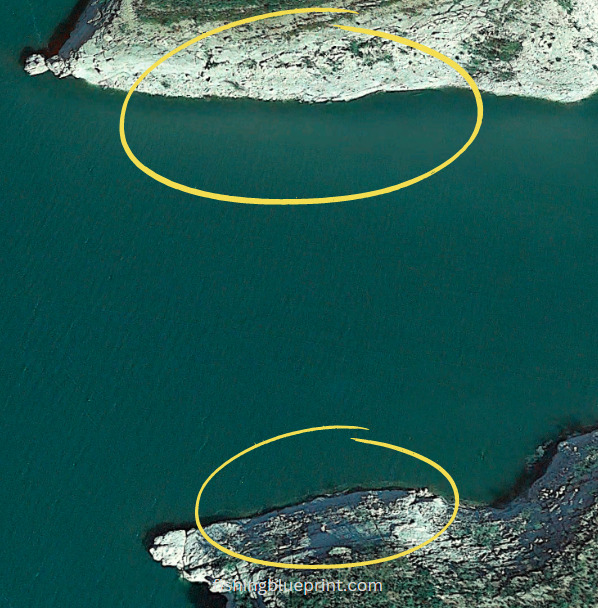
(A) Channel swing banks
Channel Swings (above) – Swings are bends in the lake bank, and they are one of the main places that hold bass. If there is even a slight bend, be sure to fish it for bass and you will likely make a catch.
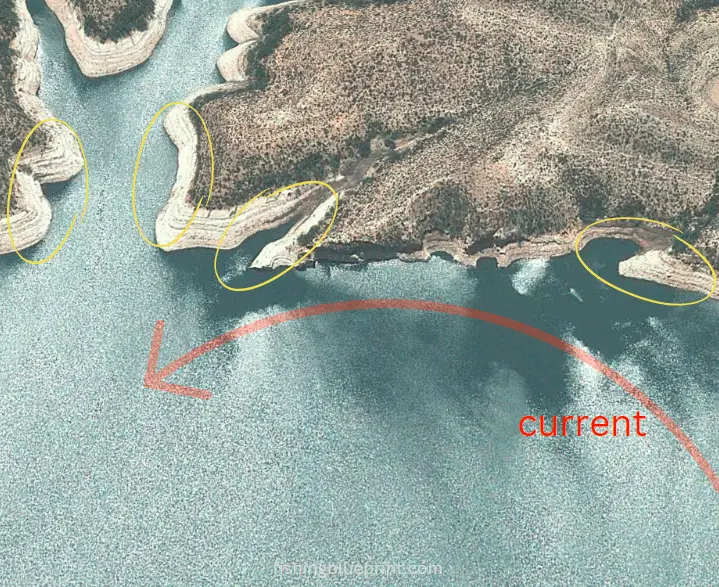
(B) Leading and trailing edges of bluff/cliff walls
Leading and Trailing Edges of Bluff/Cliff Walls (above) – The leading and trailing edges of bluff or cliff walls are another popular spot where bass go for protection, feeding, and resting year-round. Fish these walls with a jig, casting your bait down the shelves and over rocks where bass may hold.
A bluff or cliff wall with vegetation growing on it or close to it is a likely spot to find bass. Also, look for size changes in rocks such as large rocks at the bottom of the bluff and you may find a sweet spot with lots of bass there.
Sometimes bass suspend a few feet off the wall, and it is very effective to cast between the wall and the fish.
Bluff/cliff walls are one of the best spots to fish bass near a rocky bank.
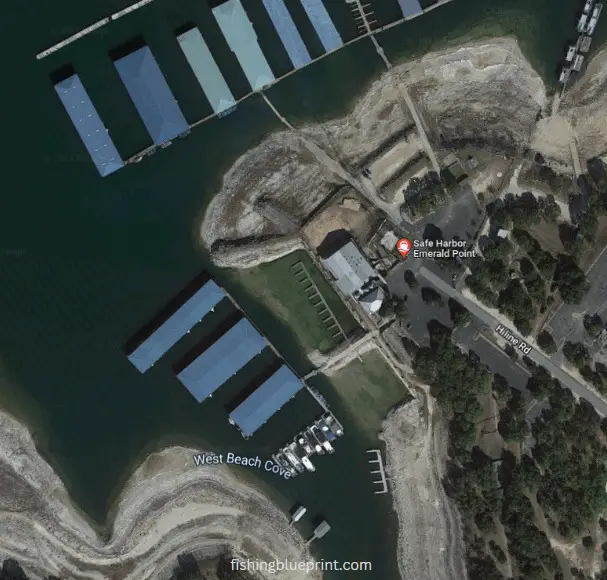
(C) Marinas
Marinas – Rocky banks are often on either side of the wooden structure of marinas. Use a square bill crankbait to fish rocky banks and riprap on the marina.
Let’s take a closer look…
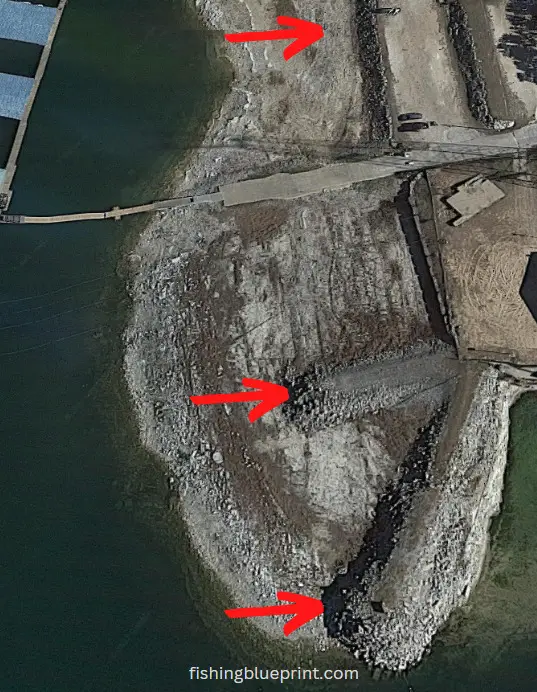
Zooming in you’ll find several rocky banks that are sure to hold fish all year long.
However, its important to do your research FIRST, not all marinas have rocky banks like this for you to fish.
You may find gaps between the rocks where bass are hiding. Bounce the crankbait off the rocks to give the bass a chance to come out and see what the commotion may be.
There is a good chance that you will jaw jack a lunker near marina rocks.
BONUS: Backs of creeks and coves with current
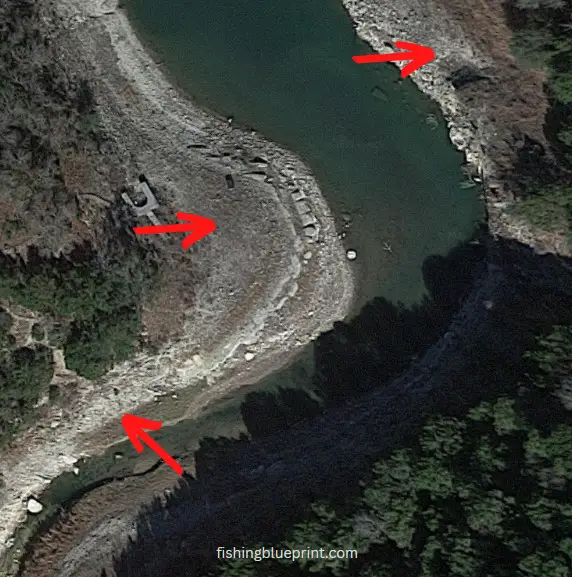
Backs of creeks and coves with nearby current can produce amazing gravel beds. Gravel areas are key points for bass and bluegill will spawn.
The key to finding these areas is to search for areas close to the current source preferably on a creek channel bend.
Which Is Better – Steep Rocky Banks or Gradual Rocky Banks?
The best rocky banks fall within a 45-degree angle and tend to hold all types of fish, including bass year-round. A steep rocky bank may fall straight down to the bottom of the lake, but a gradual rocky bank has a gradual drop.
Gradual rocky banks often provide more ledges and many more hiding places for bass than a steep rocky bank. They are often made of gravel and are usually in the backs of coves, which makes them great during the spawning season as they serve as spawning flats.
Steep rocky banks are also good and if you can find one near a spawning flat in the spring, it will hold a ton of fish. Use your fish finder to help you locate bass on a flat near the rocky bank.
Step 3: Identify the Rocky Bank With Your Fish Finder/ Sonar and Scan It
Now that you are on the water it’s time to confirm the quality of the bank you are fishing.
Step 1) I strongly suggest starting with a side scan first over the deepest section of the bank.
Then if you see anything such as a piece of secondary structures (such as a rock pile or brush pile), or if you scan to detect a school of shad or bass, then I would move on the step 2.
Step 2) After you side scan the bank, find any secondary structure and scan it with your 2D sonar and downward structure scan to see if there is any bait or active bass in the area.
Helpful Tip: One thing Edwin Evers has taught me about rocky banks is that I have to constantly be looking for secondary structures he calls "irregularities".
The secondary structures don’t have to be big and don’t have to obviously stand out… so this means it can be small or subtle.
Here’s a small list of things that I look out for when I fish a long riprap bank:
- Small contour changes like a mini point
- A turn in the bank – inward or outward
- A ledge or even a high spot that is close to the rocky bank
- Transitions changes of substrate – changes in size of the riprap on the bank (big or small)
- Rock slide
- Boulder
- Drainage ditches and culverts
- Laydowns
- Submerged brush
- An old flooded tree
Let’s see how this helpful process would be implemented on the lake…
Step 1) Start with your side scan


Then once you see something of interest, switch to your 2D sonar or structure scan
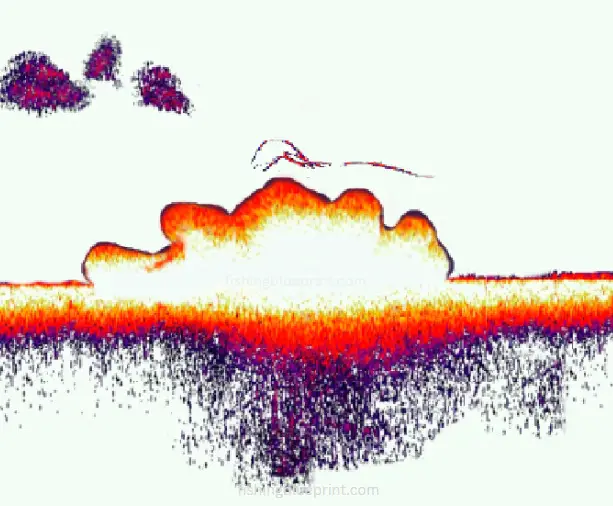
Finding Active vs. Inactive Fish
When scanning any type of structure you want to see if there are any bass in the area, and more importantly, where the bass are in relation to the structure.
If the bass are on top of the structure it signifies the bass are actively feeding. These fish are extremely catchable. Best of all, you can typically catch them using any assortment of lures.
Look at the images below. This is a downward scan image I recreated to show you what bass look like when they’re relating to the apex of the point, they are the large arcs. The smaller dots represent baitfish like shad.
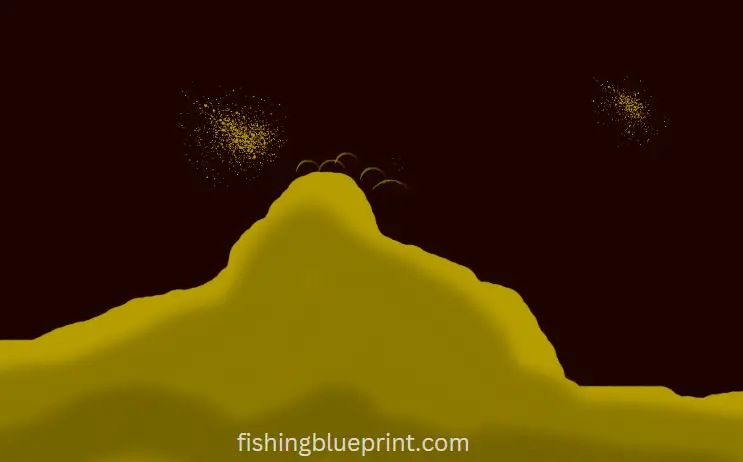
In this second picture below, locate the arcs which represent the bass.
As you can see, the bass are suspending over deeper water and way off to the side… this means they are not actively feeding.
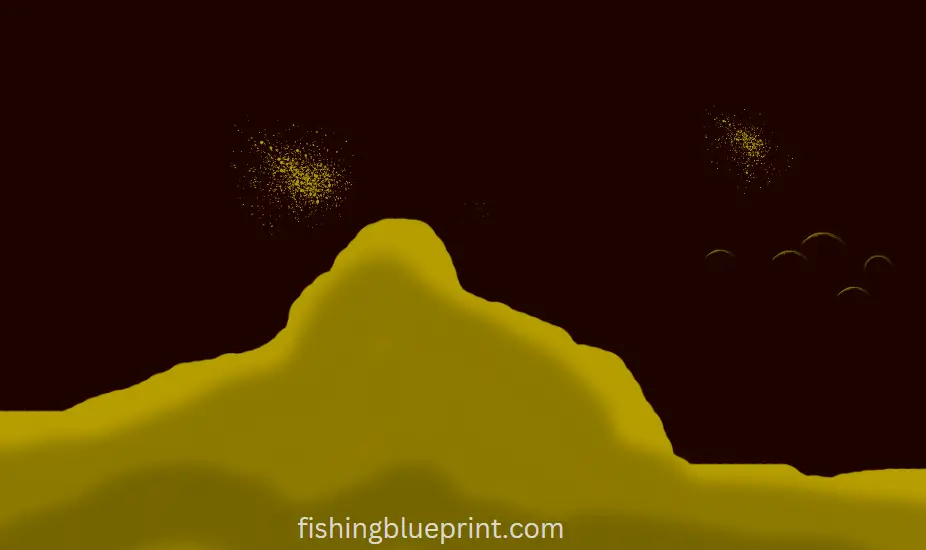
Additional Helpful Tips For Scanning Riprap Banks
- Yes, you can use your fish finder to scan a rocky bank. The fish finder will show you areas where you can find bass near the rocky banks.
- If the bank has an extensive amount of rock, a side scan will not clearly show bass.
- Another issue is that the bass may be hiding behind large riprap or boulders and will not be seen on side scan, or 2d sonar, or structure scan.
- Both 2D and down scans will show rocks and help you know their sizes. Down scan shows rocks as round or square shapes and bass will appear as arcs or as lines above the rocks.
- Sonar shows the rocks as hard bottoms with bumps. The bumps indicate the rock sizes.
- You will have to use these scans and look for spikes or hard bottoms with a thick red or yellow line confirming that they are rocks. Side scans may show the forms of rocks and fish on the bank.
Step 4: Fishing The Rocky Bank Systematically
You can become an expert at fishing riprap banks for bass by following these easy steps I personally learned from laydown fishing expert Major League Fishing Pro Brian Latimer.
Step 1 – Find The Right Bank
Choosing the right rocky bank to fish bass is important because you can be sure you’re in the right area if you have used your fish finder to confirm that bass are present there. Randomly beginning to fish along the bank probably won’t result in your boat being full of bass.
The main secret to successfully fishing a rocky bank is always to look for differences. Many of these can be seen with the naked eye rather than relying on your fish finder.
As we discussed earlier, put the odds in your favor by choosing the right bank to fish.
Step 2 – Proper Boat Position
If you’re just getting started, all you really need to know are two primary ways to position your boat, kayak, or float tube to fish a bank.
- Parallel the bank
- Cast from deep water into shallow water
Parallel the bank – paralleling the bank allows your boat to sit in the same depth of water as you follow its contours. This is great for nearly every lure for bank fishing. Crankbaits, Chatterbaits, spinnerbaits, flukes, and hard plastic jerkbaits really excel when paralleling the bank.
Casting from deep water into shallow water – When you cast your lure into shallow water and work it slowly into deeper water. This is great for sinking baits such as; jigs, Texas rig worms, drop shot, and spoons.
Step 3 – Casting In Various Depths
Some anglers will say start shallow and others will say start deep.
Starting out topwater baits in the morning or if you see the bass chasing shad. Then switching to fast moving reaction baits to pick off aggressive bass. And finally switching to slower moving baits such as jigs or Texas rigs to pick off the more reluctant bass.
I like the lesson I personally learned from BASS Pro Randy Blaukat, and that is if you don’t know where to start, I suggest pulling the boat up next to the side of the bank 2-3 feet off the bank and parallel the bank.
Helpful Tip: Based on what the water conditions are and how the bass are behaving will tell you how deep you should be fishing.
As a rule of thumb: if it’s the morning or if it’s windy when casting closer to the bank is recommended.
However, if it is bright and sunny in the middle of the day then casting deeper is recommended.
He goes on to say, if you notice a riprap point, fish it first thing in the morning and when it’s breezy.
Step 4 – Stay Versatile and Keep Multiple Baits Handy
There are many places where bass may hide in a lake with a rocky bank. It’s necessary to try different methods and approaches as you fish bass.
Part of an angler’s versatility is searching the lake for other areas that have rocks. These might be the sides of boat docks and underneath them, bridges, walkways, and anywhere that you see riprap.
Another way to stay versatile is to have several rods and baits in your boat that are ready to use if fishing circumstances change. You may start out with a shallow crankbait but the water depth suddenly falls 10 feet, so you need to change to a deep-water fishing technique.
Helpful Tip: Don’t give the bass too much time to think about it. This shallow water lure may get a response from bass who do not want to be bothered, and they are hooked into before they realize what happened.
If the bass are in a timid mood and doesn’t want to chase a bait, then I strongly recommend switching to a flipping bait, jig, a Texas rig, or a drop shot.
If the water is stained-to-dirty many anglers agree that switching to a larger creature bait is the way to crawl along the riprap. Flipping the lure allows the bait to slide over the rocks.
Texas rig worms, brush hogs, or lizards are great if you’re looking for a bait to get notices and stand out when the water is slightly stained.
Drop shot baits work great for clear water conditions. Baits can resemble a helpless leach or a small baitfish.
Most come around 4-inches long and are available in many colors.
Step 5 – Remember Your Presentation Once You Hook into a Bass
One of the secrets to bass fishing rocky or riprap banks unlock the pattern once you catch a couple of fish.
After you have a couple of bass in the boat, chances are you’ll catch more if you present your lure the same way.
You may be surprised on a certain presentation or bait that you caught the fish on… just stay open minded. Don’t give up because the bass may be hesitant and somewhat suspicious if you have already caught a bass there.
Step 6 – Fishing Rocky Banks Requires Patience
Another basic that experienced anglers agree on is that the best strategy for fishing riprap is to be patient. Fishing riprap will require you to make a ton of casts and possibly work your way down the riprap bank… even if you think it’s the best bank.
What are the Best Baits For Bass Fishing Rocky Banks and Riprap?

When choosing what bait you should you here’s a quick and easy list that helps me:
- Topwater lures, buzzbaits in the morning or on cloudy conditions.
- Crankbaits, spinnerbaits, jerkbaits, chatterbaits, umbrella rigs, underspin jigs, swim jigs, hair jigs, lipless crankbaits, and soft plastic swimbaits, perform well here in breezy conditions or during the midday.
- In contrast, slower moving baits such as drop shot, football jigs, tubes, wacky rig, Texas rig, Neko rigs, and Carolina rigs can be phenomenal when the conditions are calm or the bass are holding close to the rocks.
- Flutter spoons work great in the deepest part of the rock bank or over any secondary structures directly related to the dock.
My Personal Notes: My 2 Biggest Problems with Fishing Rocky Banks for Bass
One common frustration I had as a new angler was when I kept getting my line, bait, or lure caught in the rocks on the bank. I didn’t know how to keep this from occurring until I listened to a talk from BASS Pro Denny Brauer, then everything changed!
Now I’m paraphrasing… If you keep getting hung up, reduce the size of the weight in half, even if you think it’s too light. Then, if you can’t feel the rocks, upsize by ⅓ until you start feeling the rocks without getting snagged.
The same thing goes when you’re fishing a spinnerbait, Chatterbait, or a crankbait.
I also used to not keep in mind that on rocky banks the depth can change quickly and so I used to get snagged all the time and wonder why.
It wasn’t until I started to pay attention to the topographic map setting on my fish finder that it allowed me to get an insight on and drastic changes in depth that was in the path I was traveling.
So knowing the depth of the water under your boat or kayak and in front of it will help you know which bait and lures to use.
Helpful Tip: It wasn’t until I started to pay attention to the topographic map setting on my fish finder that it allowed me to get an insight on and drastic changes in depth that was in the path I was traveling.
Another frustration that I experienced was seeing a long bank of riprap that all looks the same. At the time my blueprint for fishing riprap banks wasn’t created so I spent hours fishing the entire bank!
It wasn’t until I learned the secret from Edwin Evers to quickly find secondary structures relating to the bank to give yourself more efficiency. I promise… once you take the time to pre-scan the bank it can give you a clearer picture of where to fish and find differences that can be much more than changes in rock sizes.
Want To Learn Where To Catch More Bass? Checkout These Articles...
- Bass Fishing CREEKS The Easy Way (In Less Than 10 Minutes)
- Warning: Bass Fishing HEAVY GRASS? [15+ Mistakes To Avoid]
- Bass Fishing POINTS in 5 Quick & EASY Steps!
- Complete 5-Step DOCK Fishing Formula
- Bass Fishing LAYDOWNS [Complete Guide + Pictures]
- Little Known Pattern for Fishing TREES for Bass.. Now and Forever
- Complete Formula For BASS FISHING ROCKY BANKS & RIPRAP
- The 5 TRUTHS about Bass Fishing BRIDGES and Avoid Wasting Time On Techniques That Don’t Work!
- Bass Fishing BRUSH PILES To Catch The Most Bass In Minimum Time!
- The 7-step Secret Formula for Bass Fishing LEDGES – Even a Complete Fishing Noob Can Use and Be 100 Times More Potent Than the Best B.A.S.S. Professional!
- The Single Best Guide to Fishing SHELL BEDS… and… Do It Fast!
- 5 Basic Elements Of Fishing HUMPS AND RIDGES No One is Talking About!
- 5 Crucial (and Unusual) Tactics You Must Do When Bass Fishing ROADBEDS!
- Top 25 Summer BANK Fishing Tips (Never Get Skunked Again)
- [EXPERT REVEALS] Bass Fishing In MUDDY WATER Secrets – 27 Tips & Mistakes To Avoid Today!
- 31 Best Tips for Bass Fishing At NIGHT (Complete Guide)
Other Bass Fishing Articles Just For You...
Funny Fishing Rules, Laws, and Regulations 2025
Crazy Fishing Laws That Will Blow Your Mind! #7 is INSANE! Strange Fishing Regulations and Laws As silly as hook and rod limits may seem,
EXPOSED! How To Use A Spinnerbait The Right Way for 2025
Are You Wondering How To Use A Spinnerbait? Or How To Work A Spinnerbait Over Grass, Logs, or Points? Well, All These Questions Are Answered
EXPOSED! Best Crankbait Colors for 2025 [Which to Buy & Avoid]
What color crankbait to use? Crankbait Color Chart I just love going into a Bass Pro Shops store and just staring at all the walls
Best Underwater Dock Lights For Fishing – 2025 Buyers Guide
Night Dock Light Fishing For Beginners Dear fellow angler, Does this sound like you? You’re someone who loves fishing but just wants to escape the
15 Best Deep Diving Crankbaits [2025 Buyers Guide – Which to Buy & Avoid]
A Complete Buyer’s Blueprint On The Best Deep Diving Crankbaits for Bass, Walleye, or Striped Bass On The Market Today Fishing deep diving crankbaits can
